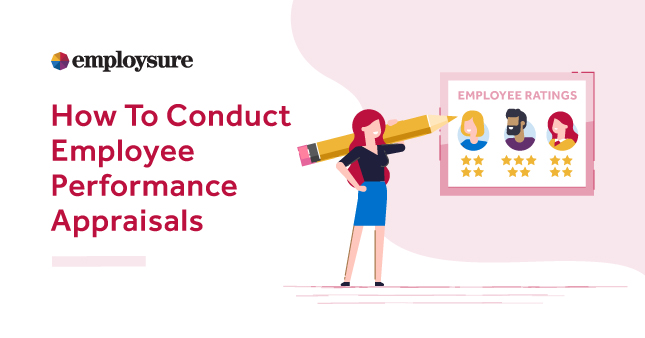

Employee performance reviews can be useful in improving your company’s performance. If done right, employees and supervisors or managers are able to share expectations and collaborate to achieve results. This can lead to increased employee engagement, reduced levels of employee dissatisfaction, performance improvement, increased motivation and morale.
What is a Performance Appraisal?
A performance appraisal is an evaluation of an employee’s job performance and contribution to the company. The performance appraisal process evaluates an employee’s achievements, skills, and growth or lack thereof in terms of company and employee goals and objectives. Performance appraisals are primarily used by supervisors and managers to provide feedback to each employee regarding their performance and serve as a basis for changing behaviour towards more effective working habits.
Steps to Conducting a Performance Appraisal
Conducting employee performance appraisals can seem like a straightforward process, but sometimes even the most experienced and competent HR practitioners, managers, and supervisors may struggle to conduct effective performance review processes. Here are a few tips that may assist in the delivery of effective employee performance appraisals and review processes.
1. Preparation
Adequate preparation assists in the likelihood of the processes succeeding. Establish a purpose for the appraisal meeting beforehand. You can start by reviewing the notes from the employee’s previous appraisals and evaluate some of their more recent work to determine any patterns in the challenges they face. Prepare a list of points to discuss with the employee in the meeting and include potential solutions.
Employee performance appraisals are two-way discussions. You may wish to create a joint agenda for the performance review meeting to guide the direction of the meeting and ensure you cover everything you intend to, highlighting both the employee’s struggles and successes.
You may wish to give the employee time to prepare for the appraisal meeting beforehand. Communicate your meeting agenda and invite your employee to share their views and perhaps conduct a self-evaluation of their performance in preparation. Consider setting out the performance review process, their role in the evaluation process and what you’re looking for from them, and exactly how you’ll evaluate their performance against company objectives
2. Documentation
Properly documenting what was discussed during a performance review may be useful for procedural and practical reasons. One way to do this is to use performance appraisal forms. They are an excellent way to assist with goal setting and tracking individual tasks and offer scope for employee self-evaluation; they should therefore form the basis of the performance appraisal meeting to help conduct objective and accurate evaluations of your employees.
You may document your employee’s performance throughout the review period, such as missed deadlines or completed projects. You can also keep track of these developments through a performance appraisal form and ask your employee to do the same. This will allow you to have a comprehensive look at your employee’s performance.
Employsure can assist you understand what documentation may be required. Call us for free initial advice on 1300 651 415
3. Feedback
Feedback from clients, as well as colleagues who’ve worked with the employee from their coworkers, boss, and any reporting staff can broaden the performance information to deliver to the employee. Consider using a structured format to make it easy to share the feedback with subordinates. Provide the employee with the feedback you’ve gathered before the meeting to allow them to digest the contents before discussing it with you at the appraisal meeting.
4. Evaluation
Evaluate employees based on goals and expectations that have been clearly set out and documented at the start of the review period or even at the start of their employment. Evaluating an employee’s performance against objectives or targets they were unaware of will make them feel blindsided. Also, keep in mind that the performance review meeting is a two-way discussion, and your employee should have input as well. Your employees are more likely to open up and be honest when they feel listened to, and have a relationship of trust with their supervisor or manager. So let the employee speak first, then respond with constructive input. After every discussion point, summarise the conversation and check the consensus with regards to goal setting and understanding of future expectations.
While it’s easy to dwell on the negatives and what the employee should’ve done, try to focus on the positives. Discuss the employee’s successes and what worked, and how they can continue to grow. But this doesn’t mean you should sugarcoat negative reviews; instead, discuss practical ways they can improve. These critiques are meant to aid the employee, so be honest and work with them to find a way forward. Offer coaching on how an employee can improve on their weaknesses, and reward success and offer the employee development opportunities that correspond with their personal goals to keep them motivated.
5. Action Plan
Research has shown that only 55% of employees believe performance appraisals are effective. To ensure your appraisals are effective, both the manager and the employee should come away from the performance review with a positive mindset and an action plan. Setting an action plan to help employees improve their skills should be a collaborative effort. Work with your employee to develop an action plan on what the employee can do to achieve their objectives and contribute towards the company’s goals. Employees that understand how their role fits in to the overall operation of the business can work more effectively.
You should consider the employee’s personal objectives and development opportunities and incorporate them into the action plan. Conclude the performance appraisal meeting by summarising what has been discussed, how and when the action plan will be implemented, and who is responsible for which tasks going forward. Monitor the employee’s progress, provide regular feedback and review the plan regularly to make sure it is still current.
Evaluate Performance and do it Regularly
A study by Adobe found that 80% of employees prefer immediate feedback to annual reviews, saying it’s more beneficial to them and contributes positively to their performance. Consider having weekly, monthly, or quarterly review sessions. Regular reviews can help reduce some of the pressure that results from a yearly employee evaluation and provide a more pro-active approach to managing performance issues before they escalate. Weekly reviews can be informal to establish an open relationship between employee and their manager or supervisor. They should focus on the potential and development of the employee and incorporate practical steps for achieving employee and company objectives.
If you incorporate these tips into your performance appraisal process, you may be able to develop a more streamlined and effective review process. Performance reviews can significantly improve employee-manager communication and enhance your relationship with employees, as well as improve your organization’s overall performance.

Get Workplace Advice Now
Call our team to receive free initial advice on any workplace relations topic.
Frequently Asked Questions
Why do Employers Evaluate Employees?
Performance appraisals or reviews are primarily used to provide feedback to each employee regarding their performance, for goal setting and to serve as a basis for encouraging employees to adopt more effective working habits.
What are Major Criteria to Assess the Performance of Employees?
The major criteria used to assess the performance of employees should be objective and measurable and can include meeting KPI’s and company objectives, ideally listed on the performance appraisal form. Employee behaviours, for example a lack of communication skills or initiative, should be discussed dispassionately by providing concrete examples of how the business has been affected, exploring reasons for the behaviours with the employee, and offering coaching or solutions, or at least practical, actionable steps for improvement.
How Often Should an Employee be Assessed?
It is up to the employer to determine how often they wish to assess their employees. However, regular informal reviews (daily and weekly) and continuous ongoing feedback are generally the most effective ways of keeping employees on track and addressing issues before they escalate. Employsure recommends quarterly formal performance appraisals of your employees.
Why Should Performance Reviews be Conducted Regularly?
Conducting reviews regularly can help maintain performance standards and also allow both the manager or supervisor more opportunities to intervene or address any concerns before matters escalate. Regular constructive feedback helps build trust between the manager or supervisor and the employee.
What are Key Performance Indicators for Employees?
Key Performance Indicators or KPIs can be anything relevant to the role. They can include:
- Meeting deadlines
- Number of sales made
- Average call length
- A performance increase on last quarter’s/year’s performance
- Number of clicks generated
What Should be Discussed in a Performance Review?
Topics to discuss in a performance review include:
- A retrospective on the time since the last review
- What was discussed in the last review
- Company goals and expectations
- Employee strengths and success
- Reward and recognition
- Areas of concern and room for improvement
- An action plan containing practical solutions and guidance to address concerns or improve (short-term)
- Employee development skills and training (long-term)
- Any concerns or issues the employee may have
- Other feedback that may be relevant from managers or supervisors, or even clients and colleagues
How do you Maintain Employee Motivation and Productivity?
This question is asked by many employers, and the answer isn’t clear cut. However, there are a few managerial actions you can take to maintain employee motivation and productivity, including regular reviews, ensuring your employee is engaged, challenged and rewarded for their efforts, and has opportunities for personal development, and that you also show leadership as a manager by setting a positive example.
How do you Handle Staff with a Negative Attitude?
Handling staff with a negative attitude can be a very hard and complex process which requires a long answer. In short, however, you should first discuss the issue with your employee in a fair and reasonable manner; their negative attitude may be due to personal issues. If you’d like further information on this process, please call Employsure on 1300 651 41 for free, initial advice.
BrightHR helping you manage your people and business
Contact us to find out how BrightHR people management software can help you manage and store your essential employee records and documents.
